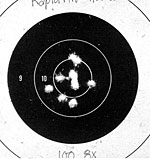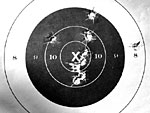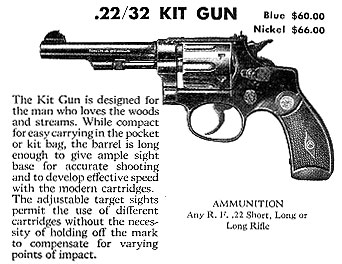Me and guns 2
Distinguished Expert medal |
My interest in shooting was re-kindled in 1982 when the NRA held their annual convention in Philadelphia. I began to shoot three times a week at the Philadelphia Law Enforcement Agency Range (a private range). I was shooting with a little .22 S&W kit gun, and had worked my way through Sharpshooter 4th bar of the NRA 50-foot Qualification Course, when the director of the range recommended that I buy a good quality target pistol. I visited my favorite gun shop and found a nice used High Standard "Victor" with which I went all the way through the NRA course to Distinguished Expert.
Along the way I managed to have my one "accident" that still gives me a chuckle. An important lesson learned.
While shooting at the range I met another member who introduced me to the Kimberton (PA) Pistol Club. Most of the folks at the range were store-keepers trying to keep in form for putting a bullet into the next robber. And there I was with a target out at 50 feet trying to get them all in a quarter sized hole with a .22. I was a real enigma to them, I'm sure.
Almost perfect! Shot in 1984. 100 8X. .22 Rapid fire (5 shots in 10 seconds, twice) at 50 feet. |
I became a member of the Kimberton Club and began to shoot at their weekly matches. I was doing really well. Shooting four times a week sure does hone your chops!
I was elected Statistical Officer of the Kimberton Valley Pistol Club, and the next year (1987) I became the Statistical Officer for the Delaware Valley Pistol League-- a group of ten clubs. I continued as Statistical Officer until 1993-- when I started to spend half the shooting season in New Zealand.
.45 Rapid fire at 75 feet. Shot in 1984. 97 3X. |
Shooting a match a week and a few practices a week took me quickly into re-loading. I bought a Lee press, and I re-loaded all my ammunition-- since I was firing about 150 rounds a week.
The second time I visited New Zealand (in 1993) I met someone through a music connection, and we found our common interest in firearms. I discovered our mutual interest only about a week before I was due to leave. I was sitting with some folks he knew and heard him say the magic words "Forty-four Russian." "Are you speaking of a Smith and Wesson?" I asked. And so another mutual interest jelled.
Firearms ownership in NZ is handled very differently than it is in the USA. It is an interesting model for those who approach the subject with some degree of rationality.
Being a left-hander, I never got used to the bolt action rifle and have always gravitated toward lever-action and pump-action rifles. Semi-automatics are also problematic because they eject to the right, resulting in a hot casing up my sleeve-- as I found when I first fired a little stock-loading Browning semi-automatic rifle.
The 22-32 Kit Gun from the 1950 Stoeger catalog. |
Being a designer, I am always looking at guns as art-- the curve of the grip, the way the flat of the receiver is blended into the round of the barrel. In pistols, I've always liked revolvers. I remember falling in love with the 22/32 Kit gun when I saw it in the Stoeger's Catalog in 1950-- thinking it was the most beautiful gun I've ever seen. I have a particular liking for revolvers with spur triggers-- like some of the small pocket Remingtons and early Smith and Wessons. I still remember the first time I saw John Ford's "Stagecoach" and John Carrardine flipped the barrel up on the little S&W when re-loading it-- an important moment for an 11 year old gun-nut! The only time I saw a Colt Root Patent for sale, I couldn't afford it. Sigh...
Update on December 1st, 2004: Well, I have done it. When I was ten years old I went to the Metropolitan Museum in NYC. I was fascinated with their arms and armor collection. While looking at the collection I saw a Colt Root model. It was the loveliest thing I had ever seen. I wanted one.
|
The Colt made "Root patent" revolver of 1855. |
Well... I've saved my allowance money all these years. A Root model came up for auction in New Zealand and I got it. It is a model 3A-- full fluted cylinder, octagon barrel, in .31 caliber. Serial number 445 indicates that it was made in early 1860. How it got to New Zealand is unknown. Here is a picture of it. It is a real cutie!
By the way... when the US Army wanted a new helmet design just before
WWII to replace the "British" helmet, they asked the people
from the Arms and Armory section of the Metropolitan Museum to design
it.
Along the way I have owned a number of firearms. Many were traded for other guns, some were traded for musical instruments. Some were sold when I decided I needed the cash more than the gun, and some were given as gifts to those who admired them. I look at the list and think, "I should have kept that..." Many I saw should have been bought, and others I wanted I could not afford. Hindsight is amazing. Those arms I was taking to NZ were stolen from my container before the container got loaded on the ship in the USA. An "inside job" and an unfortunate happenstance.
Does homeopathy have anything in common with guns?
|
A Smith & Wesson Scond model Army in .32 rim fire. Circa 1870. |
Aside from Gunpowder (black powder) being used as a remedy, I have found
three connections:
Daniel Wesson (the founder of Smith and Wesson) was an advocate of homeopathy
and endowed a hospital in Springfield, MA, The Wesson Memorial Hospital,"
which was run totally on homeopathic principles; Samuel Colt used Dr.
John Gray, the second homeopath in New York City, as his personal physician;
The Marlin Rifle Company has a homeopathic physician on staff as their
"company doctor."
It all DOES link together!




